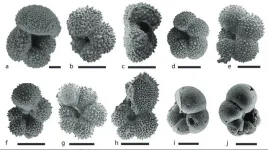(Press-News.org) In current clinical care, most critically ill adults undergoing emergency tracheal intubation receive preoxygenation through an oxygen mask. Administering supplemental oxygen to patients prior to the start of an intubation procedure increases the oxygen content in the patient’s lungs and decreases the risk of hypoxemia, low levels of oxygen in the blood. However, hypoxemia occurs during 10% to 20% of tracheal intubations in the emergency department or intensive care unit and may lead to cardiac arrest and death.
The University of Colorado co-led a trial with Vanderbilt University that compared the two most commonly used methods to preoxygenate patients prior to tracheal intubation: preoxygenation with noninvasive ventilation and preoxygenation with an oxygen mask. The trial, called the Pragmatic Trial Examining Oxygenation Prior to Intubation (PREOXI), was conducted by the Pragmatic Critical Care Research Group (PCCRG) in 24 emergency departments and intensive care units across the United States. 120 of the 1,301 patients in the trial were enrolled at the UCHealth University of Colorado Hospital.
The study results revealed that the noninvasive ventilation method, a tight-fitting respiratory mask connected to a bilevel positive airway pressure (BiPAP) machine, which pushes air at a higher pressure into the airway, cut the risk of hypoxemia in half and drastically reduced the risk of cardiac arrest compared to the oxygen mask method.
Adit Ginde, MD, MPH, co-senior principal investigator for the study and professor of emergency medicine in the CU School of Medicine, partnered with the CU Center for COMBAT Medicine and Battlefield (COMBAT) Research to obtain funding for the study from the U.S. Department of Defense.
“We believe the results of this study will change the way we care for our patients across the country and across the world and will lead to better outcomes for this life-saving tracheal intubation procedure,” Ginde says. “The [study] sites are very motivated to change and improve clinical care for the U.S. military, the sponsor of this research, and also for the general population.”
The study was published today in the New England Journal of Medicine.
Significant, practice-changing outcomes
During the trial, critically ill adults undergoing tracheal intubation were randomly assigned to two groups: preoxygenation using noninvasive ventilation or preoxygenation using an oxygen mask.
The investigators studied whether preoxygenation with the noninvasive ventilation method would prevent hypoxemia during intubation.
In the 1,301 patients enrolled rapidly over a 17-month time period, hypoxemia occurred in 57 of the 624 patients (9.1%) in the noninvasive ventilation group and 118 of the 637 patients (18.5%) in the oxygen mask group. Further, by preventing hypoxemia during tracheal intubation, preoxygenation with noninvasive ventilation also prevented cardiac arrest, which occurred in one patient (0.2%) in the noninvasive ventilation group and seven patients (1.1%) in the oxygen mask group.
“By using BiPAP, the noninvasive ventilation method, we reduce the amount of this complication of low oxygen levels by half,” Ginde says. “This magnitude of effect is unusual in any clinical trial, let alone a critical care trial, that you improve outcomes this significantly. An important secondary outcome is that the cardiac arrest rate was lower in the noninvasive ventilation group, too.”
Prior to this trial, international guidelines stated that preoxygenation with either noninvasive ventilation or an oxygen mask is acceptable, guidance that the results of this trial are likely to change.
Colorado leads breakthrough clinical implications
Ginde is eager to start implementing changes and recommendations in practice locally and globally. He and his team at the University of Colorado and UCHealth, in partnership with the CU Center for COMBAT Research and the U.S. military, are working on immediate changes to military clinical practice guidelines. With nine of the study’s authors based at CU across the Departments of Emergency Medicine, Medicine, and Anesthesiology, Ginde anticipates a smooth transition to a new standard of practice.
“We have already started clinical implementation at our site, the UCHealth University of Colorado Hospital, as well as all the other PCCRG sites participating in the trial,” Ginde says. “We have also started working with military operational and combatant commands and the Joint Trauma System to change policy and training guidelines.”
Ginde emphasizes the team effort and significance of CU’s leadership in the study, including its connection to the military and its leadership role in obtaining funding.
“This was a big team effort; the PCCRG is a is a highly effective group of sites and leaders in critical care trials across the country,” he says. “This study wouldn’t have been possible without the CU Center for COMBAT Research and their work facilitating funding from the Defense Health Agency through our partners at the US Air Force 59th Medical Wing Science and Technology Office.”
Disclaimer: The views and conclusions contained herein are those of the authors and should not be interpreted as necessarily representing the official policies or endorsements, either expressed or implied, of the U.S. Government.
END
University of Colorado co-leads multicenter randomized trial identifying method of emergency intubation preoxygenation to decrease risk of hypoxemia and cardiac arrest
A breakthrough study reveals that a noninvasive ventilation method reduces risks associated with a standard oxygen mask
2024-06-13
ELSE PRESS RELEASES FROM THIS DATE:
Quantum data assimilation: A quantum leap in weather prediction
2024-06-13
Data assimilation is a mathematical discipline that integrates observed data and numerical models to improve the interpretation and prediction of dynamical systems. It is a crucial component of earth sciences, particularly in numerical weather prediction (NWP). Data assimilation techniques have been widely investigated in NWP in the last two decades to refine the initial conditions of weather models by combining model forecasts and observational data. Most NWP centers around the world employ variational and ensemble-variational data assimilation methods, which iteratively reduce cost functions via gradient-based optimization. However, these methods require significant computational resources.
Recently, ...
Ancient ocean slowdown warns of future climate chaos
2024-06-13
When it comes to the ocean’s response to global warming, we’re not in entirely uncharted waters. A UC Riverside study shows that episodes of extreme heat in Earth’s past caused the exchange of waters from the surface to the deep ocean to decline.
This system has been described as the "global conveyer belt," because it redistributes heat around the globe through the movement of the ocean waters, making large portions of the planet habitable.
Using tiny, fossilized shells recovered from ancient deep-sea sediments, the study in the Proceedings of the National Academy of Sciences demonstrates how the conveyor belt responded around 50 ...
Pre-operative use of GLP-1s may reduce complications after metabolic and bariatric surgery in patients with extreme obesity
2024-06-13
SAN DIEGO – June 13, 2024 – A combination of GLP-1 agonists taken before metabolic and bariatric surgery may help patients with extreme obesity lower the risk of post-operative complications, according to a new study* presented today at the American Society for Metabolic and Bariatric Surgery (ASMBS) 2024 Annual Scientific Meeting
Patients with extreme obesity, a body mass index (BMI) of 70 or more, face a higher risk of complications from surgery compared to patients with lower BMIs. Studies have shown weight loss before surgery can mitigate risk but lifestyle intervention ...
Why many lung cancer patients who have never smoked have worse outcomes
2024-06-13
The reason why targeted treatment for non-small cell lung cancer fails to work for some patients, particularly those who have never smoked, has been discovered by researchers from UCL, the Francis Crick Institute and AstraZeneca.
The study, published in Nature Communications, shows that lung cancer cells with two particular genetic mutations are more likely to double their genome, which helps them to withstand treatment and develop resistance to it.
In the UK, lung cancer is the third most common type of cancer and the leading cause of cancer death. Around 85% of patients with lung cancer have non-small cell lung cancer (NSCLC), and this is the most common type found in patients ...
APA poll finds younger workers feel stressed, lonely and undervalued
2024-06-13
Younger workers are struggling with feelings of loneliness and a lack of appreciation at work and tend to feel more comfortable working with people their own age, according to a survey by the American Psychological Association.
The 2024 Work in America survey, conducted online by The Harris Poll of more than 2,000 working U.S. adults, found that three in 10 U.S. workers reported that people in their organization who are not close to their age do not see the value in their ideas (32%). That number was significantly higher for workers aged ...
Shedding light on the state of genetic counseling for hereditary transthyretin-related amyloidosis
2024-06-13
Early detection and treatment of hereditary transthyretin-related amyloidosis via genetic counseling are crucial. Yet, not all at-risk individuals seek genetic counseling, and management for presymptomatic carriers remains unclear. To tackle these knowledge gaps, a research team from Japan conducted a retrospective study on over 200 people who sought genetic counseling at a medical center, shedding light on the current advantages and limitations of current practices.
Hereditary transthyretin-related amyloidosis (AATRv amyloidosis) is a rare inherited ...
Trametinib shows promise for children with relapsed or refractory JMML
2024-06-13
Bottom Line: The MEK inhibitor trametinib (Mekinist) was an effective treatment for pediatric patients with relapsed or refractory juvenile myelomonocytic leukemia (JMML) enrolled in a phase II clinical trial, with seven of 10 patients alive after a median of two years.
Journal in Which the Study was Published: Cancer Discovery, a journal of the American Association for Cancer Research (AACR)
Authors: The senior author is Mignon Loh, MD, who is the director of the Ben Towne Center for Childhood Cancer Research and the head of the Division of Pediatric Hematology, Oncology, Bone ...
New way to spot beetle-killed spruce can help forest, wildfire managers
2024-06-13
A new machine-learning system developed at the University of Alaska Fairbanks can automatically produce detailed maps from satellite data to show locations of likely beetle-killed spruce trees in Alaska, even in forests of low and moderate infestation where identification is otherwise difficult.
The automated process can help forestry and wildfire managers in their decisions. That’s critical as the beetle infestation spreads.
The Alaska Division of Forestry and Fire Protection calls the spruce beetle “the most damaging ...
New study reveals combined use of Donepezil and Memantine increases the probability of five-year survival of Alzheimer’s disease patients
2024-06-13
Alzheimer's disease is the world’s most common neurodegenerative disease, affecting more than 50 million people globally. Alzheimer’s disease is also among the most fatal, landing as one of the top five causes of death worldwide. However, most currently available treatments are limited to alleviating the disease’s symptoms.
Now, a new study led by Chapman University researchers has explored the efficacy of using two existing Alzheimer’s disease drugs simultaneously to reduce mortality. It is one of the largest and ...
Number of over 65s with type 1 diabetes has almost tripled in 30 years
2024-06-13
The number of people aged 65 and older with type 1 diabetes increased from 1.3 million in 1990 to 3.7 million in 2019, while death rates fell 25% from 4.7 per 100,000 population in 1990 to 3.5 in 2019, finds an analysis of data from over 200 countries and regions in The BMJ today.
Overall, the results show that more people with type 1 diabetes are living longer. However, death rates fell 13 times faster in high income countries compared with low and middle income countries, indicating that substantial ...
LAST 30 PRESS RELEASES:
Making lighter work of calculating fluid and heat flow
Normalizing blood sugar can halve heart attack risk
Lowering blood sugar cuts heart attack risk in people with prediabetes
Study links genetic variants to risk of blinding eye disease in premature infants
Non-opioid ‘pain sponge’ therapy halts cartilage degeneration and relieves chronic pain
AI can pick up cultural values by mimicking how kids learn
China’s ecological redlines offer fast track to 30 x 30 global conservation goal
Invisible indoor threats: emerging household contaminants and their growing risks to human health
Adding antibody treatment to chemo boosts outcomes for children with rare cancer
Germline pathogenic variants among women without a history of breast cancer
Tanning beds triple melanoma risk, potentially causing broad DNA damage
Unique bond identified as key to viral infection speed
Indoor tanning makes youthful skin much older on a genetic level
Mouse model sheds new light on the causes and potential solutions to human GI problems linked to muscular dystrophy
The Journal of Nuclear Medicine ahead-of-print tip sheet: December 12, 2025
Smarter tools for peering into the microscopic world
Applications open for funding to conduct research in the Kinsey Institute archives
Global measure underestimates the severity of food insecurity
Child survivors of critical illness are missing out on timely follow up care
Risk-based vs annual breast cancer screening / the WISDOM randomized clinical trial
University of Toronto launches Electric Vehicle Innovation Ontario to accelerate advanced EV technologies and build Canada’s innovation advantage
Early relapse predicts poor outcomes in aggressive blood cancer
American College of Lifestyle Medicine applauds two CMS models aligned with lifestyle medicine practice and reimbursement
Clinical trial finds cannabis use not a barrier to quitting nicotine vaping
Supplemental nutrition assistance program policies and food insecurity
Switching immune cells to “night mode” could limit damage after a heart attack, study suggests
URI-based Global RIghts Project report spotlights continued troubling trends in worldwide inhumane treatment
Neutrophils are less aggressive at night, explaining why nighttime heart attacks cause less damage than daytime events
Menopausal hormone therapy may not pose breast cancer risk for women with BRCA mutations
Mobile health tool may improve quality of life for adolescent and young adult breast cancer survivors
[Press-News.org] University of Colorado co-leads multicenter randomized trial identifying method of emergency intubation preoxygenation to decrease risk of hypoxemia and cardiac arrestA breakthrough study reveals that a noninvasive ventilation method reduces risks associated with a standard oxygen mask


